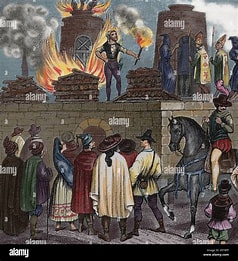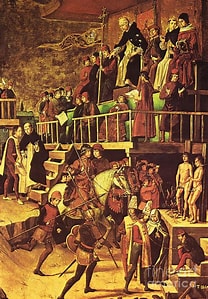The Spanish Inquisition
Introduction
The Spanish Inquisition is often regarded as one of the most notorious chapters in the history of religious persecution. Established in 1478, it served as a tool for the Catholic Monarchs, Ferdinand II of Aragon and Isabella I of Castile, to enforce religious orthodoxy in Spain. Over the course of several centuries, the Inquisition was responsible for the persecution, torture, and execution of thousands of individuals accused of heresy, particularly targeting Jews and Muslims who had converted to Christianity. This article will explore the origins, methods, and lasting impact of the Spanish Inquisition, shedding light on its profound implications for religious freedom and human rights.
Understanding the Spanish Inquisition
What Was the Spanish Inquisition?
The Spanish Inquisition was a judicial institution established by the Catholic Monarchs to maintain Catholic orthodoxy in their kingdoms. It aimed to root out heresy among converted Jews (conversos) and Muslims (Moriscos) who were suspected of secretly practicing their former faiths.

Key Objectives
- Religious Uniformity: The primary goal was to ensure that all subjects adhered to Catholicism.
- Political Control: The Inquisition also served as a means for the monarchy to consolidate power by eliminating dissent and opposition.
Historical Context
The Rise of Anti-Semitism
Pre-Inquisition Tensions
Anti-Semitism had deep roots in Spain long before the establishment of the Inquisition. Jews had lived in Spain for centuries, contributing significantly to its culture and economy. However, periodic violence against them culminated in widespread resentment.
The 1391 Pogroms
In 1391, violent riots erupted against Jewish communities across Spain, resulting in thousands of deaths and forced conversions. This event marked a turning point that set the stage for future persecution.
The Reconquista
The Reconquista was a centuries-long campaign by Christian kingdoms to reclaim territory from Muslim rule. By 1492, when Granada fell to Ferdinand and Isabella, Spain was united under Christian rule. This victory intensified desires for religious homogeneity.
Establishment of the Inquisition
Papal Approval
In 1478, Ferdinand and Isabella sought papal approval to establish an Inquisition in Spain. Pope Sixtus IV issued a bull granting them authority to appoint inquisitors who would investigate heresy.

The Role of Tomás de Torquemada
Grand Inquisitor
Tomás de Torquemada was appointed as the first Grand Inquisitor in 1483. He became synonymous with the brutality of the Inquisition, overseeing widespread arrests and executions.
Implementation of Policies
Torquemada implemented harsh policies aimed at rooting out heresy. He encouraged public confessions and established rigorous interrogation methods that often included torture.
Methods of Persecution
Torture Techniques
The Inquisition employed various forms of torture to extract confessions from accused individuals:
- The Rack: Victims were stretched on a device that dislocated limbs.
- Water Torture: A method where water was forced into a person’s mouth until they nearly drowned.
- Strappado: Victims were suspended by their arms, causing excruciating pain.
Public Executions
Autos-da-fé
Public executions known as autos-da-fé (acts of faith) became spectacles where condemned individuals were burned at the stake. These events served to instill fear in the populace while demonstrating the power of the Church.
Psychological Impact
The fear generated by these public displays effectively silenced dissent and reinforced compliance among those who might have considered opposing authority.
Targeted Groups
Conversos: The Converted Jews
Background on Conversos
Many Jews converted to Christianity during periods of intense persecution, often under duress. Despite their conversion, conversos faced suspicion and discrimination.
Continued Persecution
The Inquisition targeted conversos for practicing Judaism secretly. Accusations could stem from trivial evidence or personal vendettas, leading to severe consequences.
Moriscos: The Converted Muslims
Forced Conversions
Similar to conversos, Moriscos were Muslims who converted to Christianity but remained under suspicion. Their cultural practices were often viewed as heretical.
Expulsion Policies
By the early 17th century, Moriscos faced increasing persecution culminating in mass expulsions from Spain in 1609-1614.
Broader Impact on Society
Erosion of Diversity
The systematic expulsion and execution of Jews and Muslims led to a significant loss of cultural diversity within Spain. This homogenization stifled intellectual growth and creativity.
Economic Consequences
The expulsion of Jewish communities resulted in economic decline as skilled laborers left Spain. Many industries suffered due to a lack of expertise that had previously thrived under Jewish influence.
International Reactions
Limited Global Awareness
While atrocities were occurring within Spain, international awareness was limited. Most European nations were focused on their own affairs during this tumultuous period.
Humanitarian Efforts
Some individuals and organizations attempted to intervene or provide aid to those persecuted by the Inquisition. However, these efforts were often met with resistance from authorities.
Legacy of the Spanish Inquisition
Long-Term Effects on Religious Freedom
The Spanish Inquisition has left a lasting legacy regarding religious freedom. Its brutal methods serve as a cautionary tale about intolerance and oppression based on faith or belief systems.
Influence on Future Legal Systems
The practices established during the Inquisition influenced legal systems across Europe regarding how heresy was prosecuted. It also laid groundwork for future discussions about human rights.
Commemoration and Education
Memorials and Museums
Today, various memorials and museums commemorate victims of the Spanish Inquisition. These sites serve not only as reminders but also as educational resources about religious intolerance throughout history.
Importance of Education
Educating future generations about events like the Spanish Inquisition is crucial for fostering tolerance and understanding among diverse communities today.
Conclusion: Remembering History’s Lessons
The Spanish Inquisition stands as a stark reminder that intolerance can lead to horrific consequences when left unchecked. By examining this dark chapter in history—its causes, methods, and impacts—we can better understand our responsibility toward promoting human rights today.
As we reflect on these lessons learned from past atrocities let us commit ourselves towards fostering understanding compassion among diverse communities worldwide! Together we can work towards ensuring history does not repeat itself—because every life matters!
FAQs
1. What triggered the establishment of the Spanish Inquisition?
The establishment was triggered by a desire for religious uniformity following the Reconquista; Ferdinand and Isabella sought papal approval to combat heresy among converted Jews and Muslims.
2. How many people were affected by the Spanish Inquisition?
Estimates suggest that tens of thousands were executed or imprisoned during its operation; exact numbers vary widely depending on sources but range from 2,000 up to 32,000 deaths attributed directly to inquisitorial actions.
3. What methods did inquisitors use during interrogations?
Inquisitors employed various torture techniques such as water torture, strappado (hanging by arms), and physical beatings aimed at extracting confessions from accused individuals.
4. How did society react to public executions?
Public executions created an atmosphere of fear; they served both as warnings against heresy while reinforcing compliance among those who might have considered opposing authority figures or institutions.
5. What is being done today regarding education about this period?
Many institutions promote education about events like the Spanish Inquisition through courses focusing on human rights issues; memorials also serve educational purposes while commemorating victims’ experiences throughout history!


